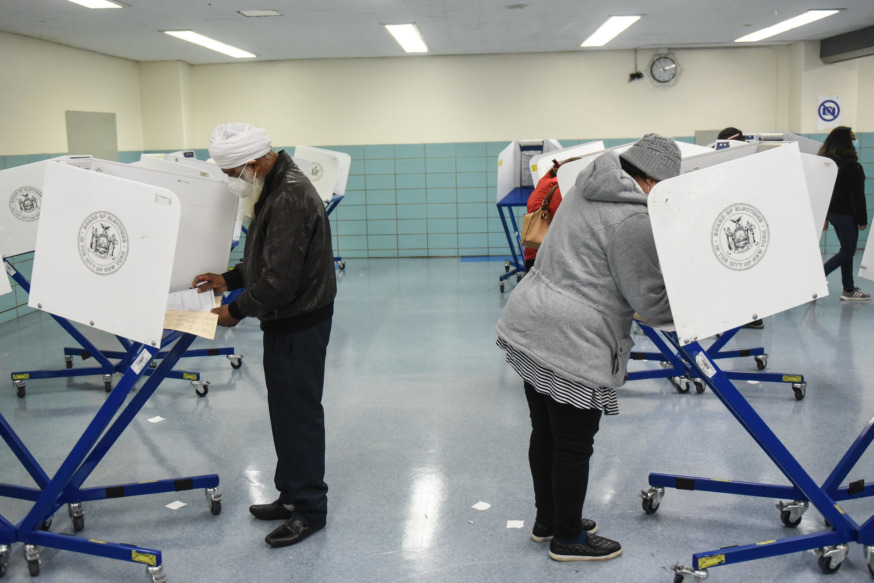
Voters cast their ballot at a polling site in South Ozone Park on Election Day. (Michael Appleton/ Mayoral Photography Office)
Nov. 6, 2020 By Allie Griffin
A higher percentage of Queens voters cast their ballots in support of President Donald Trump on Nov. 3 than in the 2016 election, preliminary results show.
About 30 percent of Queens ballots went for Trump versus roughly 22 percent in 2016, according to preliminary results from the New York City Board of Elections.
Though the majority of votes in the borough — about 69 percent — went to former Vice President Joseph Biden, Hillary Clinton gained the favor of a larger portion of Queens voters in 2016 when she brought in roughly 75 percent of votes.
The current results from the 2020 election are based off early voting and Election day votes, with nearly 96 percent of scanners reported at the time of publication. They don’t include the unprecedented number of absentee ballots New Yorkers cast in light of the coronavirus pandemic.
Biden is likely to gain more ground in Queens when absentee ballots are counted, as more Democrats chose to send their votes via mail than Republicans, according to analysts.
Still Trump has gained about eight percentage points in the borough this election after an often turbulent presidency.
The typically red areas of Queens including Northeast Queens, Howard Beach and the western side of the Rockaway peninsula account for a significant portion of Trump’s votes.
However, Trump gained votes in more moderate and Democratic areas as well, according to a map of the election results.
Trump gained ground from 2016 to 2020 in the Central Queens neighborhoods of Middle Village, Maspeth and Glendale. He earned about 70 percent of ballots in some sections of these neighborhoods in 2020, up from slightly more than half of the votes in 2016. (click here for a map of neighborhood breakdowns)
Martha Ayon, a Queens-based Democratic political consultant, said Trump’s gains in many Queens neighborhoods was an eyeopener for many progressive residents who forgot that many of their neighbors have conservative leanings.
Other Queens neighborhoods where Clinton won the 2016 election with a slim margin switched to a nearly 50/50 split on the Biden vs. Trump ballot.
In sections as Elmhurst, Jackson Heights and Woodside, the number of votes for Trump grew from around 15 to 20 percent of votes in 2016 to 25 to 30 percent this presidential election.
Southeast Queens and Western Queens continued to remain Democratic strongholds this election, but a map of the election results across the borough this year illustrate a shift from the 2016 election — with the blue in Queens fading.
Ayon said many in the Democratic party overlooked the moderate voters in the borough.
“I think the Democratic party — because the polling was so, I guess, comforting — I think a lot of people underestimated how much work the Republicans were doing to get out their own vote and we saw that in Queens,” Ayon said.
Queens is historically moderate, she said.
The borough gained national attention in 2018 when progressive newcomer Alexandria Ocasio-Cortez beat long-time incumbent and Queens Democratic Party head Joseph Crowley in the primary election.
However, Ocasio-Cortez’s progressive politics is fairly new for the borough, Ayon said.
“Queens has always had this very moderate [side],” she said. “What AOC has brought to Queens is very new.”
Ayon added that the left often acts in an echo chamber and misses more moderate voices as a result — as shown in this election.
She said the results of the presidential election — with growing red and beige areas on the map — show that the Queens voters and New York City residents overall may seek a more moderate mayor in the 2021 election.
“This beige and red that’s going around shows me that there’s a better path to victory for a McGuire, a Shaun Donovan, an Eric Adams than the progressives think,” Ayon said. “The map is showing that there’s an audience that’s open to somebody in the middle.”
